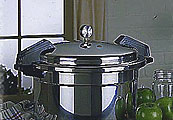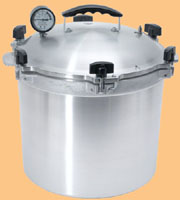
My mother was a great cook. I loved nothing more than coming home from school and smelling her home-made spaghetti sauce simmering away on the stove, or her German potato salad, a hint of vinegar still in the air, or the aroma of her famous oatmeal cookies. However, walking into the kitchen and hearing the spit and hiss of her pressure cooker would leave me breathless with anxiety. I just KNEW that thing was going to blow and send the lid spiraling right into my face.
Fast forward X number of years. Pressure cookers today are certainly not like the ones our mothers used in the “old” days. However, if you are like me, you may not know too much about them. So, in the interest of education, here is some information I’ve compiled from various internet sites.
I decided to
highlight in red the benefits to using these cookers. There is quite a bit of information, so I will do this in 2 installments. Stay tuned for the rest of the information next week!
What Exactly Is a Pressure Cooker?

Pressure cookers look like other kitchen pots, except their lids are a bit more elaborate. How they work is that they completely seal the pot. When the liquid inside boils, it is trapped inside the pot. Having nowhere else to go, steam builds up pressure. This results in
higher cooking temperatures and shorter cooking times.
The pressure of the trapped steam can be measured in pound of force per square inch or PSI. You will often find this term in pressure cooking recipes. It refers to how many pounds of pressure per square inch you will be cooking with. Don't worry if this sounds very technical. The instructions that came with your pressure cooker will tell you how to read the PSI.
The gasket or rubber ring is another important component of today's pressure cookers, as this makes a seal that traps in steam and heat and allows pressure to build. The gasket fits on the side part of the cover. In order to make sure you get a good seal, make sure all the components are clean and free from food particles.
Even in the old days, most pressure cooker disasters could usually be attributed to user error. Nonetheless, today's pressure cookers offer a much higher safety level than their predecessors. For one thing, you can't open them until the pressure is down to 0 PSI.
Today's pressure cookers have at least three valves for safety and will automatically defuse pressure should it build too high.
Different types of pressure cookers have different styles of valves (refer to the instructions that came with yours), but if you hear hissing or noise coming from the cooker, it's the valve telling you to check the pressure.
Why Use a Pressure Cooker At All?
Nutritional Boost: Due to the
shorter cooking time and the fact that food is cooked in less liquid that gets boiled away,
more vitamins and minerals are retained than with conventional cooking methods.
Saves Time: Food
cooks up to 70% faster in a pressure cooker, making it a wonderful tool for when you come home after work and have to get dinner on the table in a hurry. You can put ingredients in the pressure cooker and by the time you're finished tidying up the kitchen you can have a wholesome, hearty home cooked meal.
Energy Efficient: As less cooking time is needed,
less energy is needed to accomplish the task.
Cooler Kitchen: As all the steam and heat stays within the pot,
your kitchen stays cooler than with traditional stovetop or oven methods.
 Cleaner Kitchen:
Cleaner Kitchen: As all pressure cooker foods are cooked in a covered pot, there are no messy splashes or spatters to clean up and no boiled over foods - ever!
How to Buy a Pressure Cooker

You'll find a variety of pressure cookers on the market, usually ranging from 4 to 8 quarts. If you can only afford one, a
6 quart model is good for most jobs, but go larger if you have a big family.
The pots are made of aluminum or stainless steel and like with all cookware,
you get what you pay for. I prefer the stainless steel models as they are generally higher quality, heavier pots, which always results in better cooking with less danger of food sticking to the bottom. The heavier stainless steel models are also great because you can brown or saute foods in them before cooking under pressure, without dirtying another pot.
Contribute to the Cook'n Club!
DVO would love to publish your article, prose, photography and art as well as your cooking, kitchen and nutrition tips, tricks and secrets. Visit the Newsletter Submission / Win Win for All section in our Forum for more information and details.



